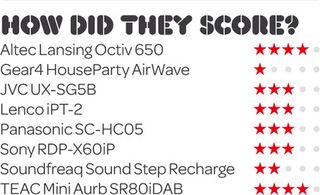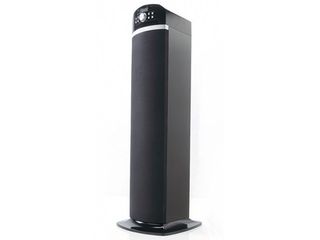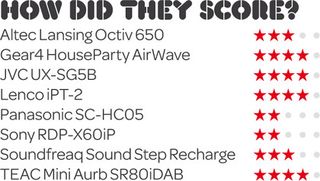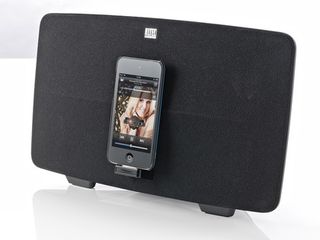Best iPod and iPhone speaker dock: 24 tested
Speaker docks for your iPod or iPhone both cheap and pricey!

Test one: Sound quality
Why you can trust TechRadar
We're moving well past impulse-buy territory here; as the price edges over that £100 mark, you want to be sure you're getting a good product for your cash. So let's first of all strike one of these off the bill, since it sounds, quite frankly, dreadful compared to the others.
We're talking about the Gear4 HouseParty AirWave. While it boasts plenty of extra features, the sound's about as flat as a open bottle of Coke that's been sitting in the fridge for two weeks.
The Soundfreaq Sound Step Recharge also failed to excite us. The whole picture was just a bit, well, meh, especially for £150. There's some treble clarity but not much, little in the way of bass, and vocals sound a bit constrained. Like with the Gear4 HouseParty AirWave, your money's paying for the added features, rather than pure audio quality.
The Panasonic SC-HC05 also left us disappointed with its lack of attention to detail at the treble end. There's bass aplenty - which makes dance tracks sound good - but with the top end so weak, you lose a dimension from most other styles.
Might makes right
Now, the giant Lenco iPT-2. You can feel the testosterone oozing from its imposing form even before you dock your iPhone in it. And when you do, Lenco is keen for you to know about its audio might, especially the thumpingly powerful subwoofer. It's the kind of bass you feel deep in your bones, and it goes loud enough to fill a reasonably sized room.
The caveat is that it's light on the treble. It does have a two-band EQ you can alter to taste, turning down the bass and boosting the treble if you wish, but even when you crank the latter right up, there's not the clarity that others offer. Decent for dance and R&B, but we'd recommend one of the other docks for some added sophistication.
The JVC UX-SG5B, with its separate speakers, produces the sort of stereo separation and spatial sound that you just can't get with a one-piece dock; big thumbs up, in our eyes (or should that be ears?). Its overall sound is solid and fairly balanced, if unspectacular. The bass isn't as full as you get with the Lenco iPT-2 or Altec Lansing Octiv 650, and the treble isn't as clean, but vocals come to the fore nicely. And because they're separate speakers, there's always the option to hook up different ones.
Moving to the understated Sony RDPX60iP, we at last get some of that treble crispness that's been missing so far. Songs that sounded flat on all bar the TEAC SR80iDAB and Altec Lansing's Octiv 650 suddenly have a sparkle about them. The bass won't pound in the same way as with the Lenco iPT-2, but it's adequate if you're just listening at lower volumes, especially with the Mega Bass setting.
TEAC's SR80iDAB impressed us, thanks to its excellent balancing of the different parts of our music. The treble's clean but not tinny, the bass is well-defined (if a bit weak for bassy pop and dance anthems) but the vocals stand out beautifully.
Finally, there's the Altec Lansing Octiv 650. We've always been in two minds about this one. It'll produce beautifully clean treble, creating a bright and detailed sound picture. Then there's its subwoofer, which - even when dialled right down using the built-in EQ - is constantly thumping away, just in case you forget it's there. We don't mind this, since it undoubtedly adds depth and fullness to your music, but some may find it too much. And if you push the bass EQ the other way, it'll shake your floors.
Test results

Test two: extra features

Plenty of good added features here: all eight have remote controls, and we especially liked the more substantial one that comes with the TEAC SR80iDAB. Those provided by Lenco, JVC and Altec Lansing give a good amount of control, too.
And speaking of wirelessness, the Soundfreaq Sound Step Recharge, Panasonic SC-HC05 and Sony RDP-X60iP let you send audio to them over Bluetooth, meaning your device needn't be docked, and the Sound Step Recharge has a built-in battery too, so doesn't even have to be plugged into the mains. Thumbs up.
Video outputs are also popular, with composite sockets on the models from Soundfreaq, Lenco, TEAC, and Altec Lansing. The latter also offers component video out. This feature is useful if you keep lots of videos on your iPhone or iPod and want to watch them on your TV, but remember that composite quality is low.
Good input
All eight have additional audio inputs for greater versatility. The Lenco iPT-2 and TEAC SR80iDAB have RCA (red and white phono connectors), with the rest all having 3.5mm aux input sockets. The iPT-2 also has an SD/MMC slot, while the systems from TEAC and JVC have USB ports for sound input.
While we're on the topic of the JVC UX-SG5B, it even has a CD player and FM radio. You'll also find FM and DAB radios in the TEAC SR80iDAB and Gear4 HouseParty AirWave. The latter dock even boasts a built-in internet radio receiver. Add to this the clock and alarms and it seems like the perfect bedside dock, but the control buttons are tricky to press.
Test results

And the winner is… Altec Lansing Octiv 650 £129

The importance of choosing a dock to suit your needs is highlighted here more than it ever has been. Our gong goes to the Altec Lansing Octiv 650, for reasons we'll get to shortly, but take a moment to consider the Sony RDP-X60iP and TEAC SR80iDAB.
At £120, the RDP-X60iP makes an excellent audio system for in a small room, such as your study, student hall or bedroom. It's relatively small and the sound that emanates from its speakers is balanced.
We also like the TEAC SR80iDAB, primarily for its ability to provide a nicely balanced sound picture where it picks out the vocals well. But we just felt its bass was a tad on the weak side to do justice to styles of music that require a bit of extra depth.
So our winner is the Octiv 650. Ultimately, speaker docks must fulfil one key purpose: to help you get as much enjoyment as possible out of your favourite music. And whatever genre we chose, the 650 delivered. The bass can be overpowering, we don't dispute that. We found ourselves turning it right down and boosting the treble using the built-in EQ to get the sound picture we wanted for a lot of genres.
But requiring you to adjust the sound to taste is no crime; different styles of music benefit from different settings, and the fact that you can tweak things here is a plus. And if you do want some pounding bass, the Octiv 650 will deliver it without fuss, without compromising treble clarity. The unit itself is fairly small and unobtrusive, and at £129, it's not prohibitively expensive either.
Current page: iPod and iPhone speaker docks £100 - £150
Prev Page iPod and iPhone speaker docks £60 - £99Get daily insight, inspiration and deals in your inbox
Get the hottest deals available in your inbox plus news, reviews, opinion, analysis and more from the TechRadar team.
